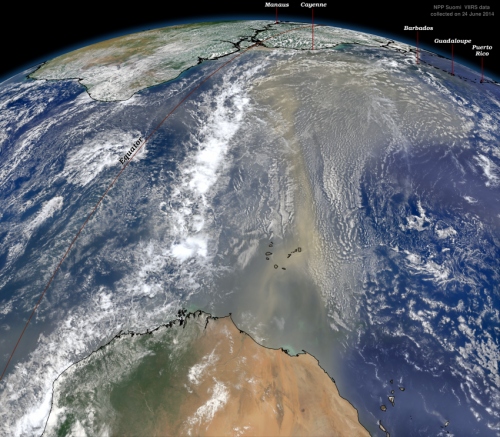Study of African dust transport to South America reveals air quality impacts

A new study that analyzed concentrations of African dust transported to South America shows large seasonal peaks in winter and spring. These research findings offer new insight on the overall human health and air quality impacts of African dust, including the climate change-induced human health effects that are expected to occur from increased African dust emissions in the coming decades.
Researchers from the University of Miami (UM) Rosenstiel School of Marine and Atmospheric Science and colleagues analyzed the dust concentrations in aerosol samples from two locations, French Guiana's capital city Cayenne and the Caribbean islands of Guadeloupe, to understand the amount, source regions, and seasonal patterns of airborne dust that travels across the North Atlantic Ocean.
The study showed clear seasonal cycles at both locations – with peak concentrations at Cayenne from January to May and from May to September at Guadeloupe. In addition, the results showed that dust concentrations during peak periods exceeded World Health Organization (WHO) air quality guidelines. The airborne dust on Guadeloupe exceeded WHO air guidelines on 258 of 2799 days (9.2%) and on Cayenne they were exceeded on 246 of 2765 days (9.0%).
"The dust concentrations measured on Cayenne were far greater than any those of any major European city from pollutants," said Joseph Prospero, UM Rosenstiel School professor emeritus and lead author of the study. "The fine-particle dust concentrations exceed the WHO air quality standard and could have broader implications on respiratory health throughout the region, including in the Caribbean and the southeastern United States."
Persistent winds across Africa's 3.5-million square mile Sahara Desert lifts mineral-rich dust into the atmosphere where it travels the more than 5,000-mile journey towards the U.S., South America and Caribbean. Seasonal dust plumes are linked to changes in dust source regions and changes in large-scale weather patterns. The dust can penetrate deep into the human respiratory system due to its fine particle size, according to Prospero.
According to the study's authors, quantifying the amount and sources of atmospheric dust concentrations is also important to improve future climate change predictions.
More information: The paper, titled "Characterizing the annual cycle of African dust transport to the Caribbean Basin and South America and its impacts on the environment and air quality," was published in the Early View online edition of the American Geophysical Union's journal Global Biogeochemical Cycles.
Journal information: Global Biogeochemical Cycles
Provided by University of Miami




















